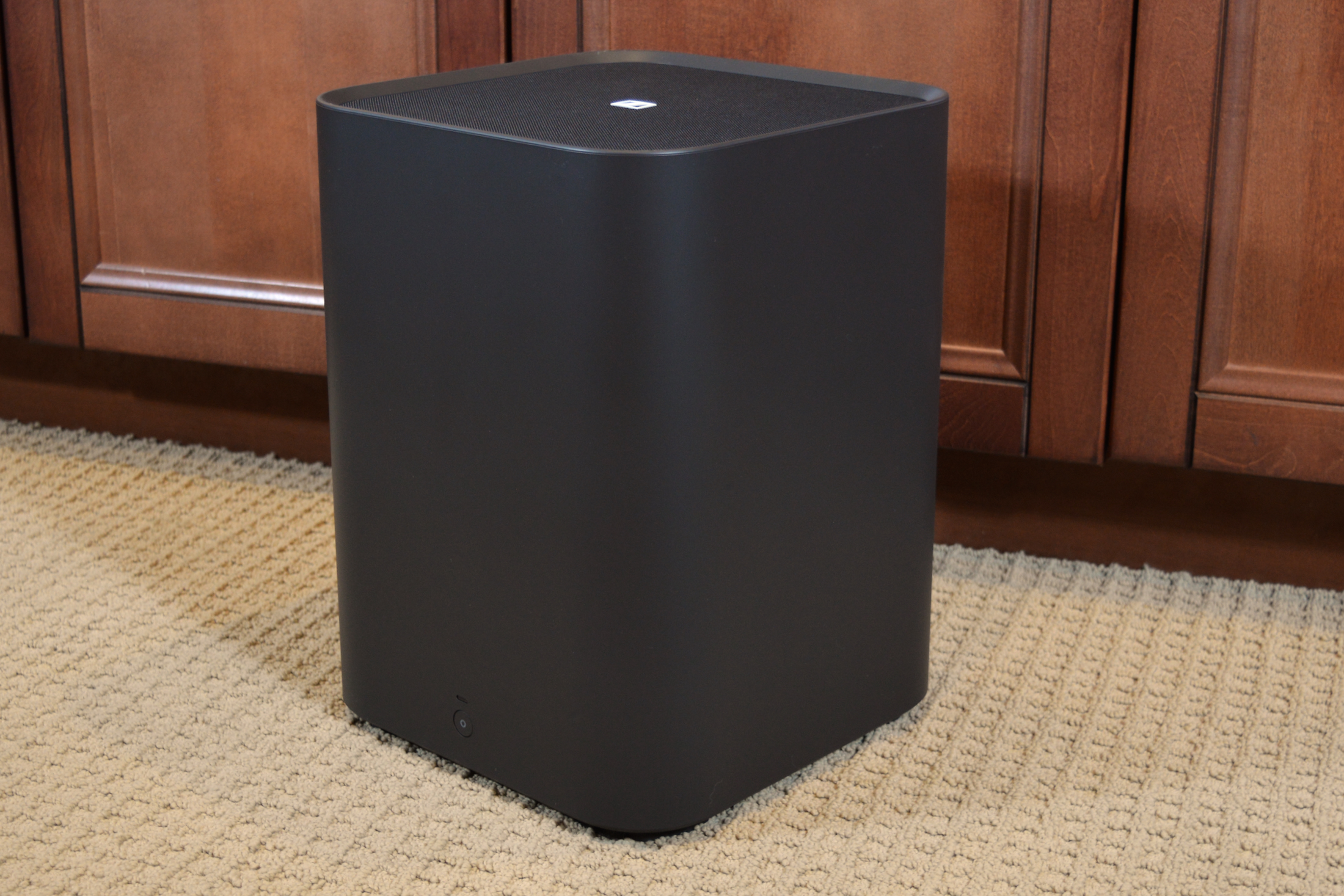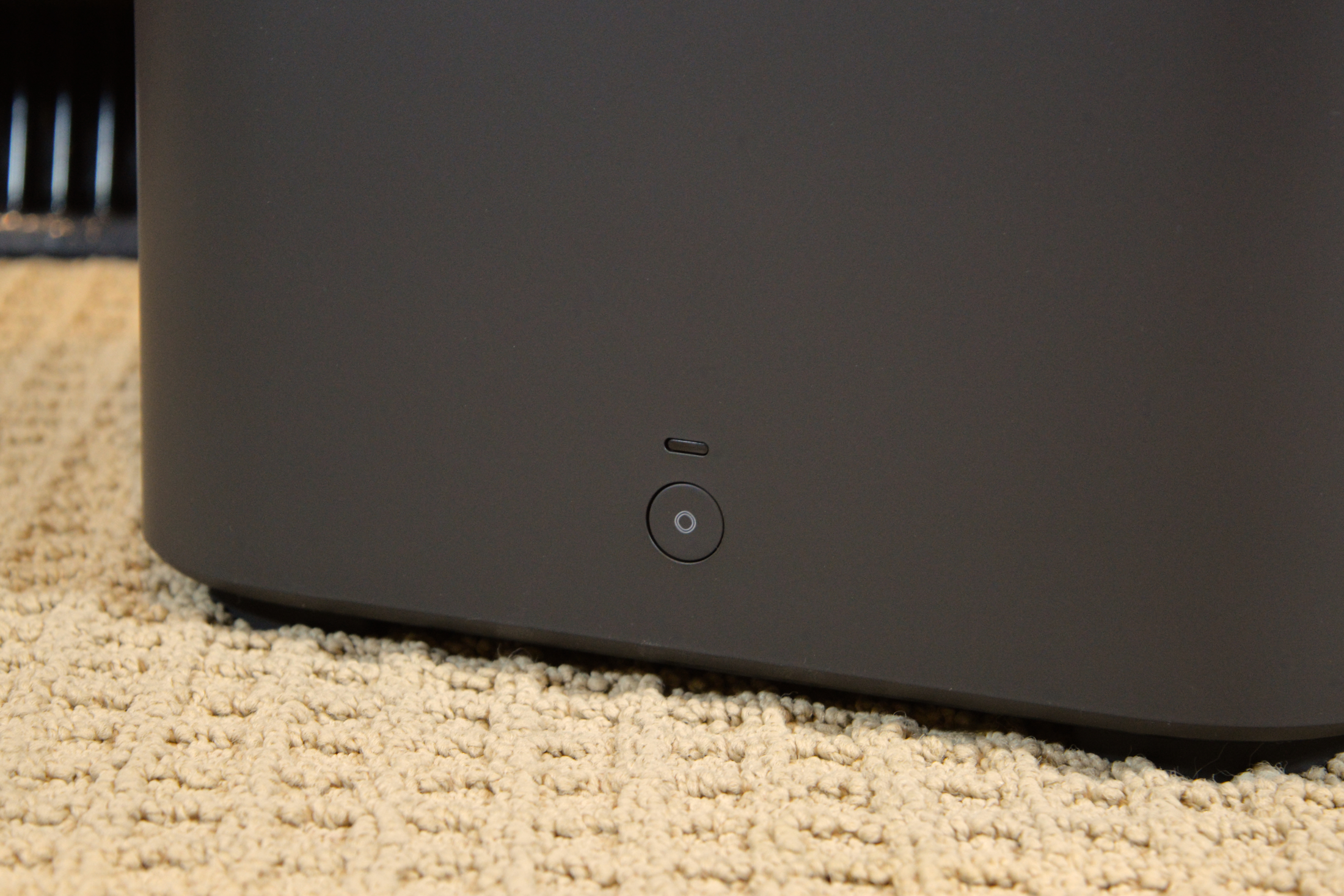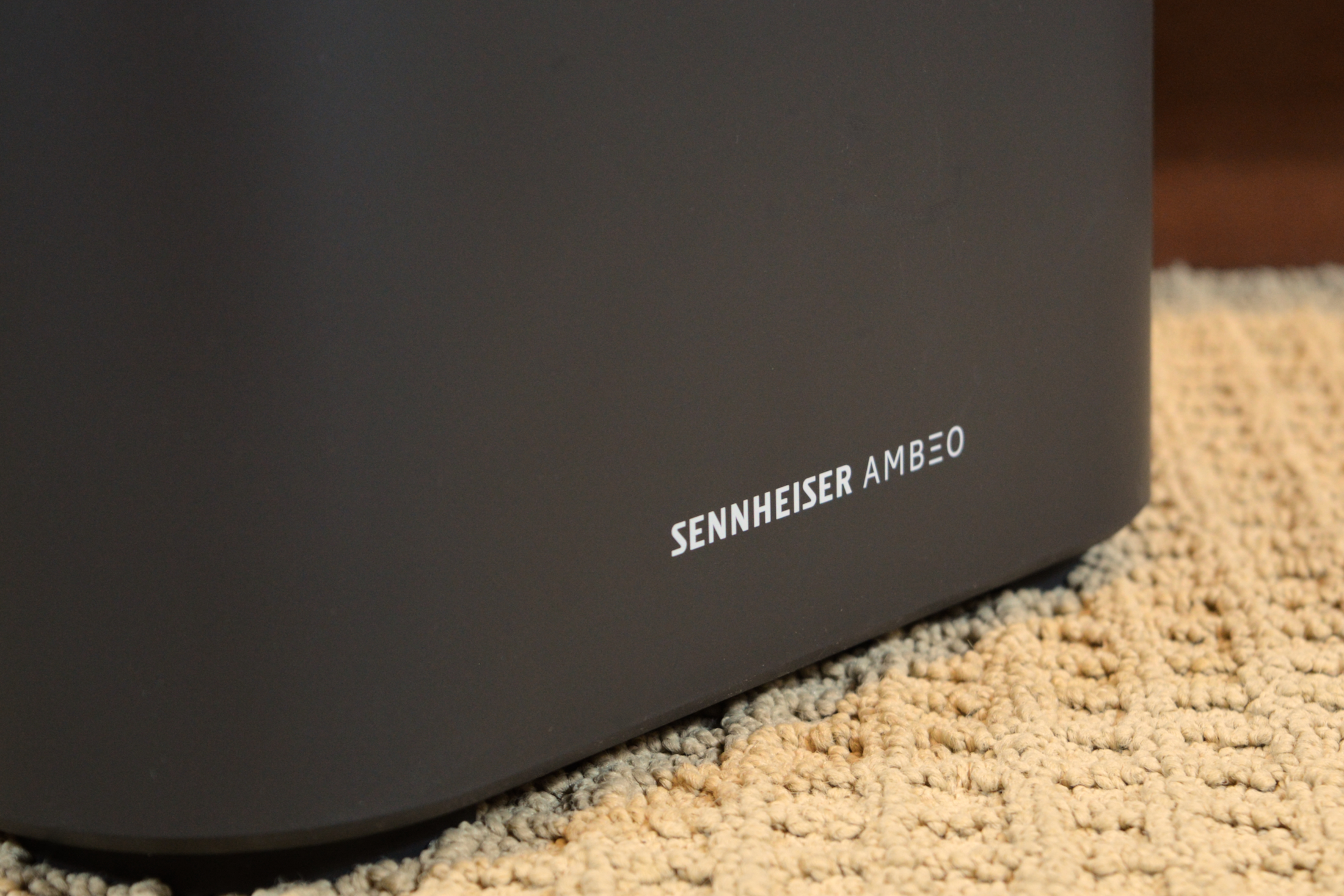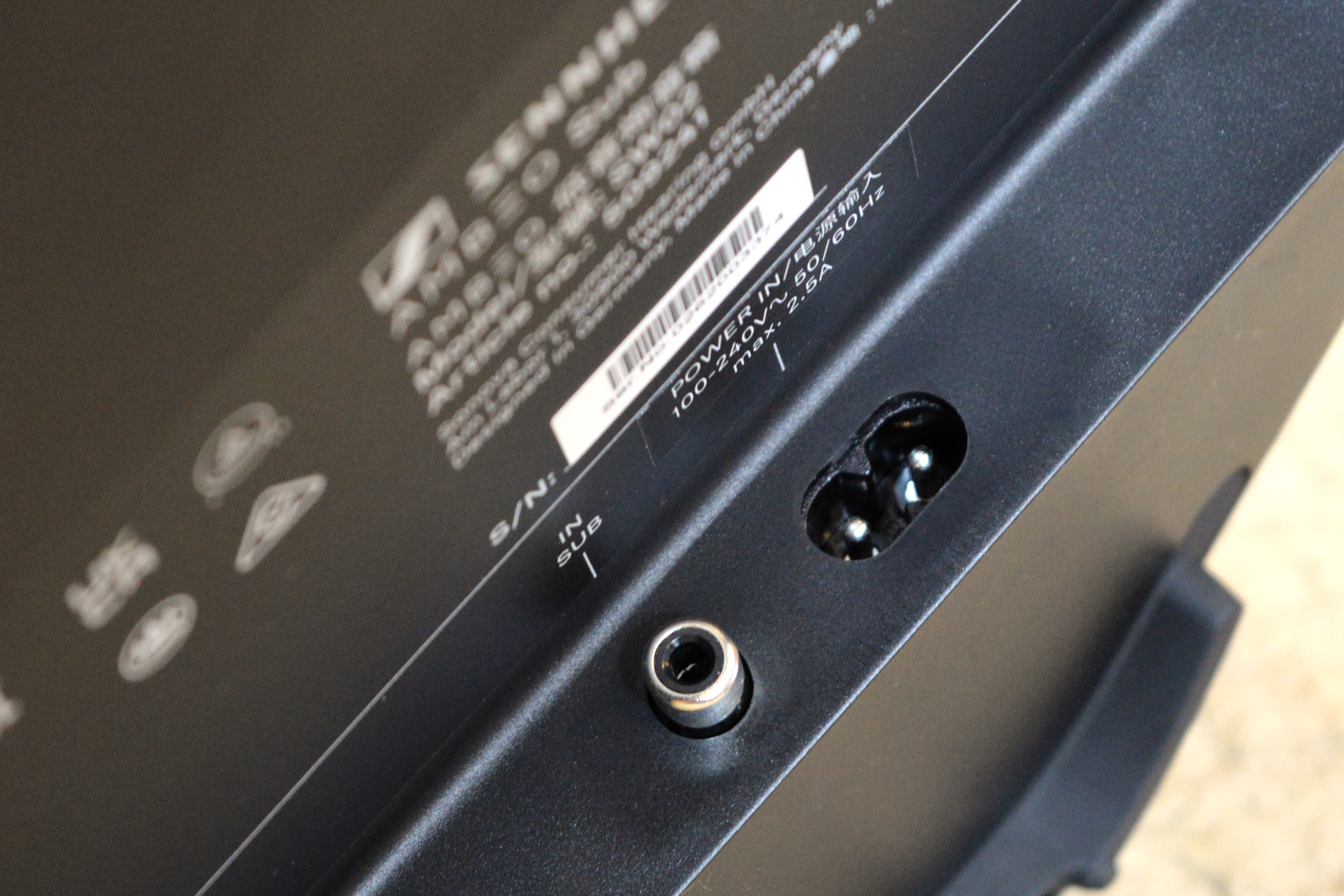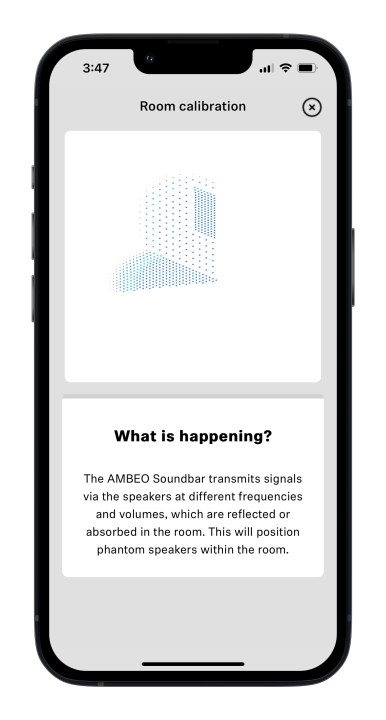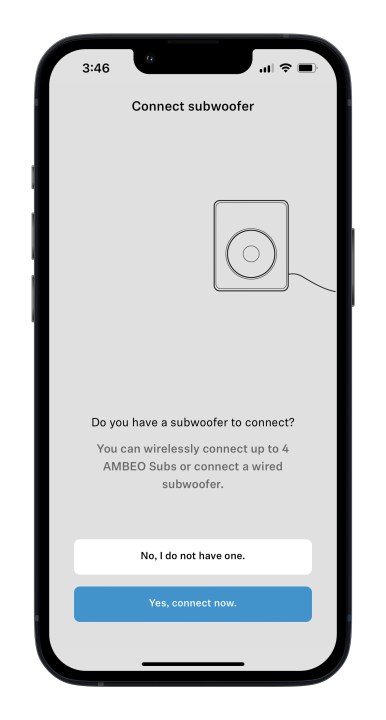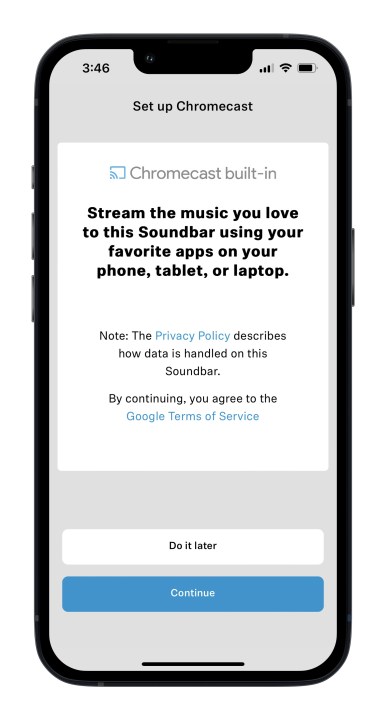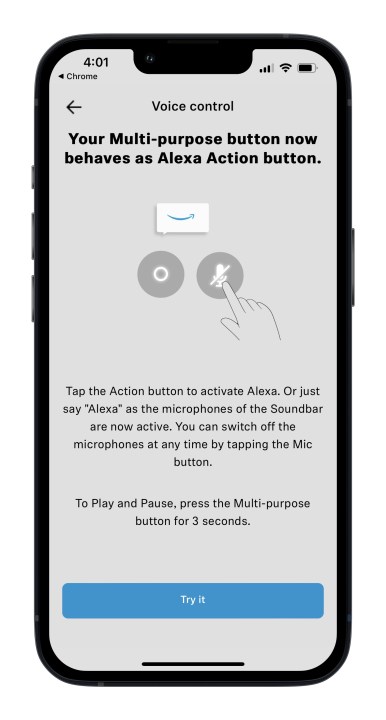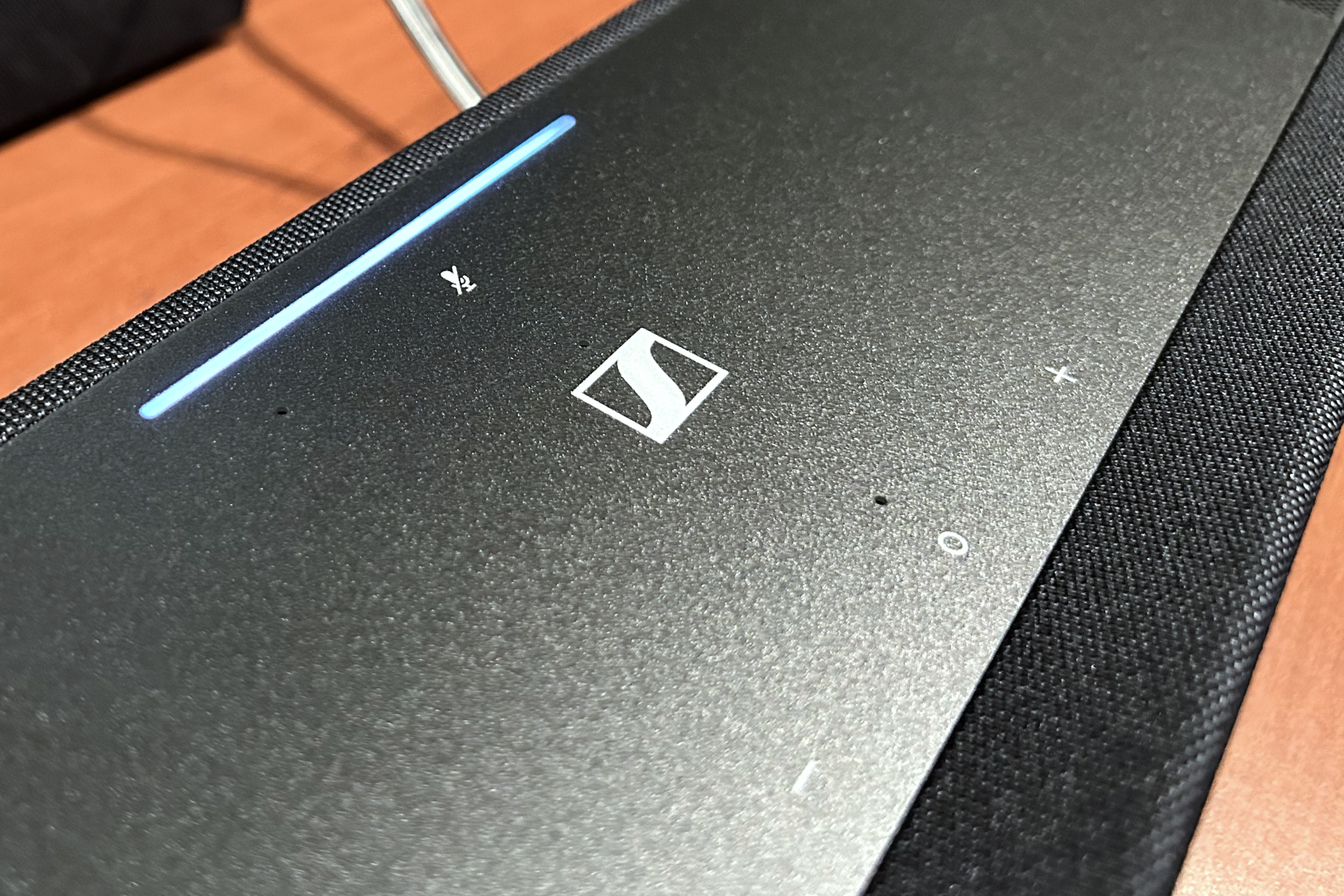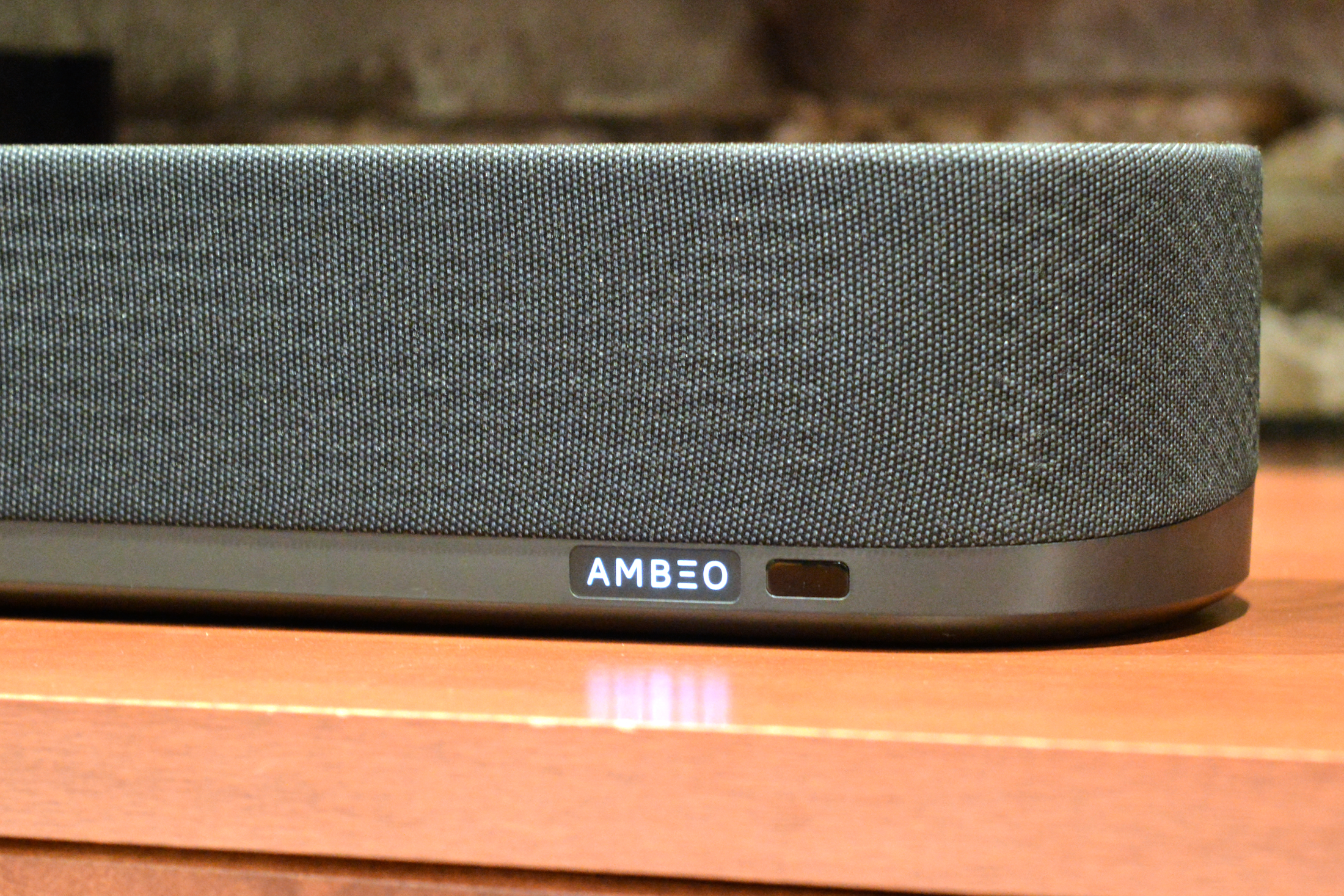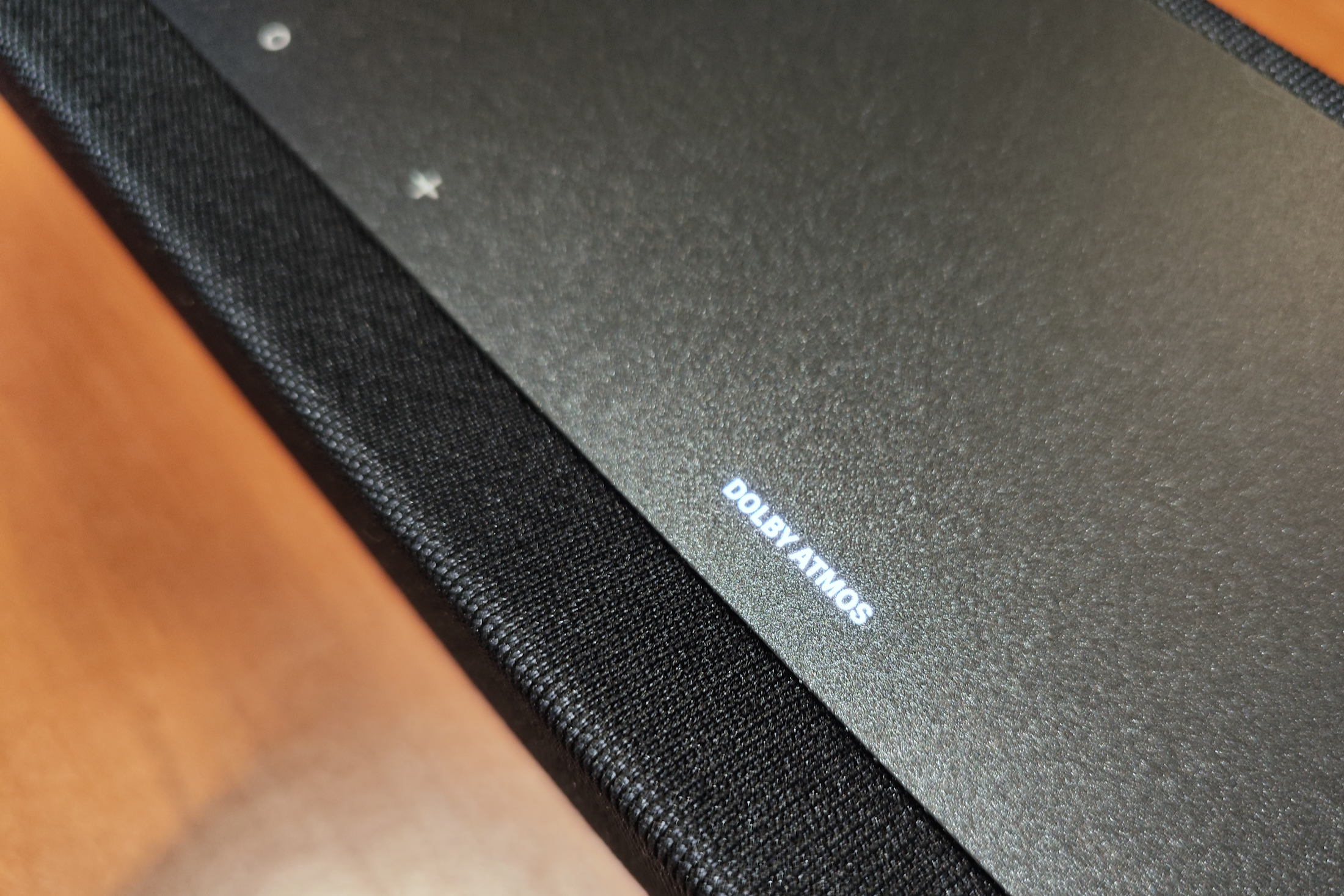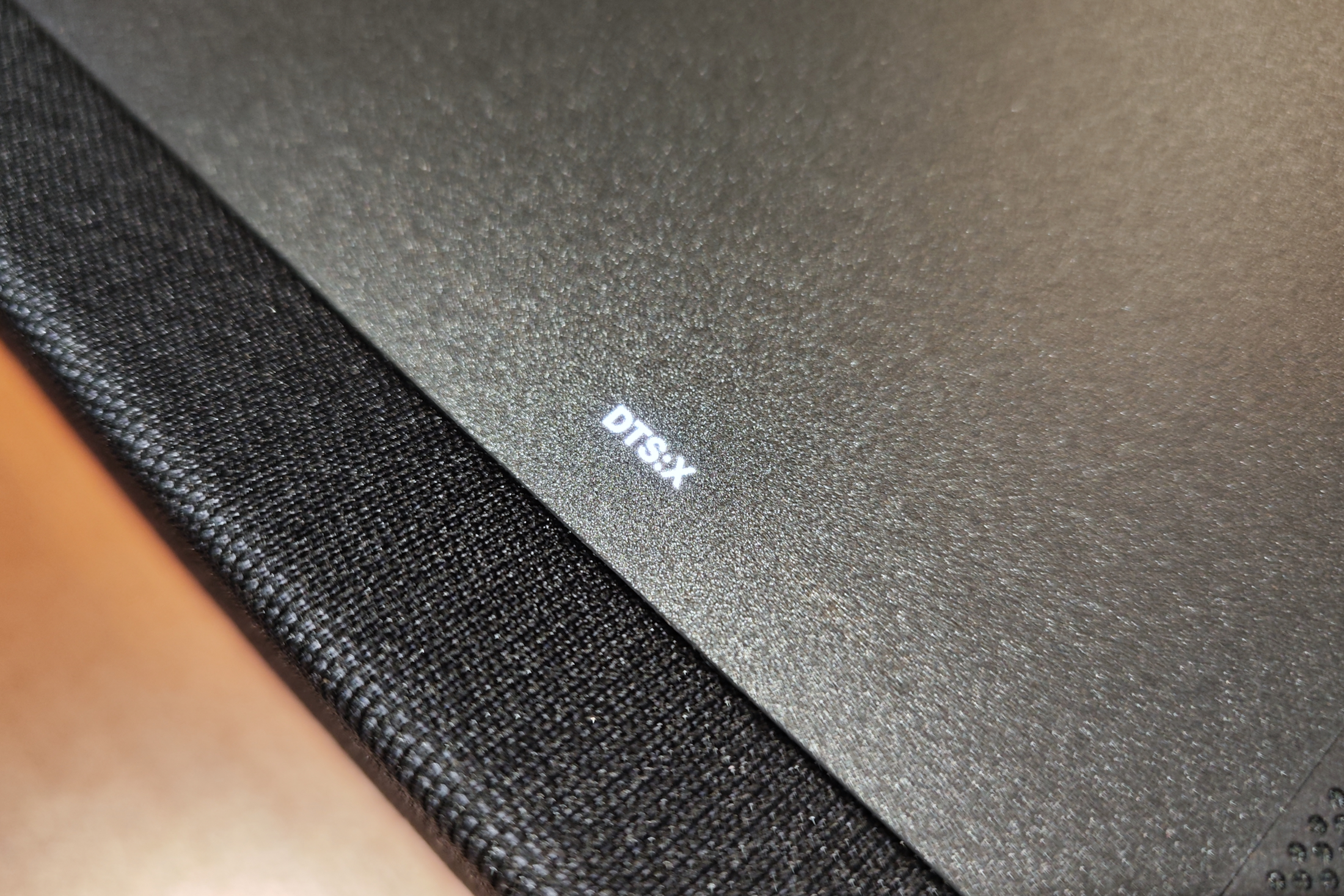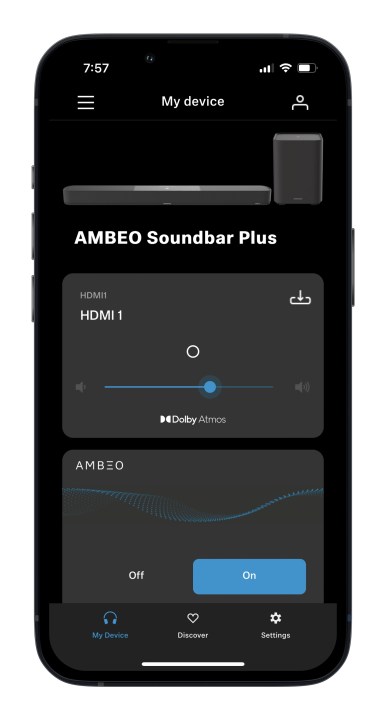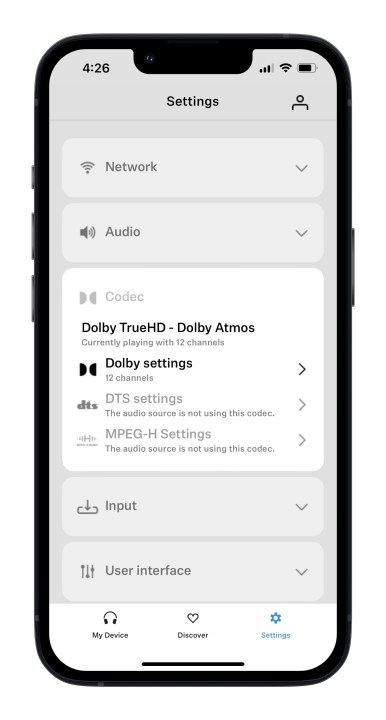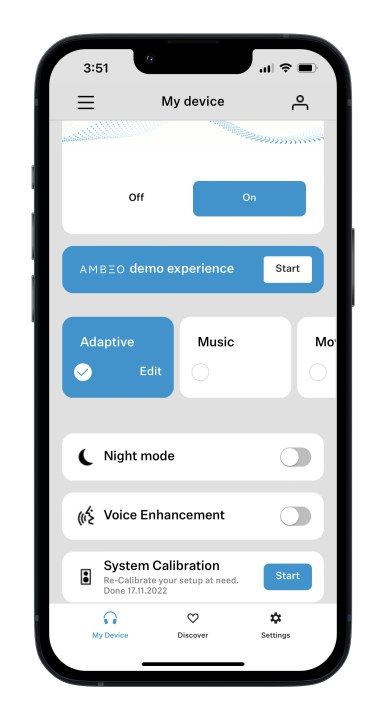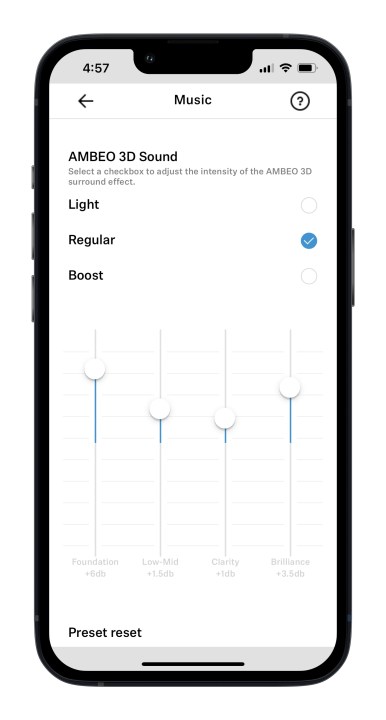- Fantastic 3D sound
- Lots of connections
- Built-in room tuning
- Up to 4 wireless subs/1 wired sub
- AirPlay/Chromecast/Tidal Connect
- Alexa built-in
- Dolby Atmos/DTS:X
- Sony 360/MPEG-H
- Still expensive
- Only HDMI 2.0a
- Relies heavily on mobile app
- Weird Alexa integration
When Sennheiser’s mighty Ambeo Soundbar debuted in 2018, it caught a lot of people off guard. Not only was it the company’s first soundbar — and not only did it cost $2,500,making it one of the most expensive you could buy — it blew reviewers away with its 3D Dolby Atmos capabilities.
Still, as impressive as it was, most pundits wondered whether we’d ever see a smaller, more accessible version that could still deliver on that Ambeo experience. It took a few years, but Sennheiser’s answer is here, in the form of the smaller and more affordable (though still expensive) $1,500 Ambeo Soundbar Plus.
Now the only question is whether lightning has struck twice — or is this new Ambeo just another Dolby Atmos soundbar?
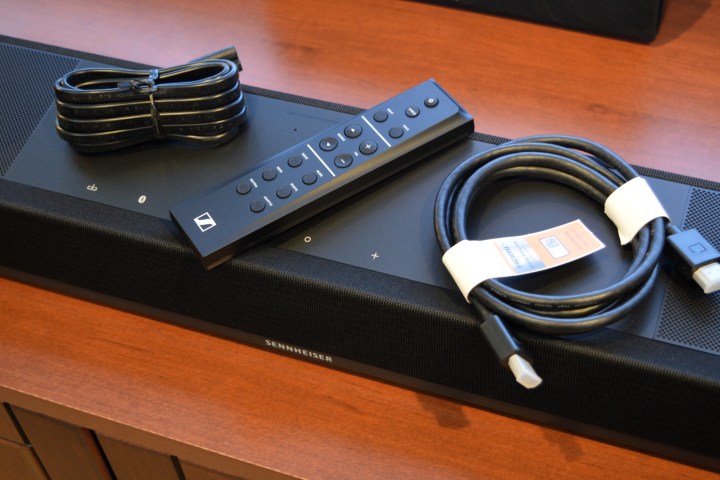
Good packaging
But before we get into the juicy bits about how this thing sounds, let’s cover some more functional ground. Sennheiser deserves major props for its packaging of the Ambeo Soundbar Plus. Everything right down to the protective wrapper that covers the speaker is made from easily recycled paper or cardboard, with the sole exception of the black plastic carry handle.
Inside that box, you’ll find a power cable, a premium certified HDMI cable, a remote control, and a quick start guide.
That’s everything you need to get going, but it’s not everything you need to know. Be prepared to go in search of the full manual on Sennheiser’s website if you want to understand all of the speaker’s settings and functions. There are a lot of them, and only some are intuitive enough to figure out on your own.
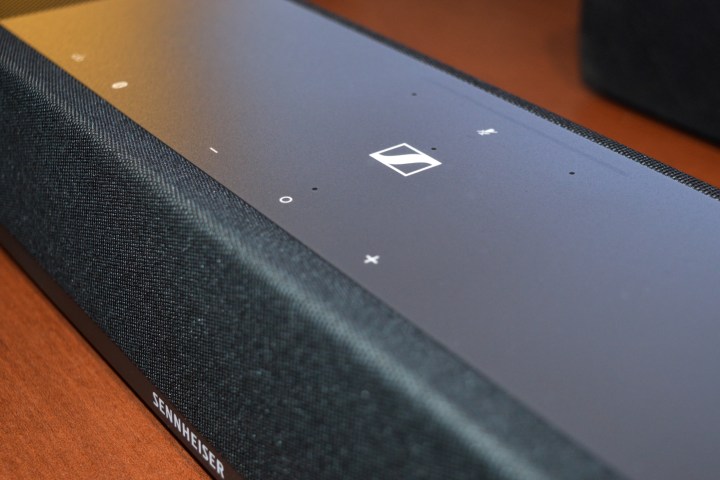
The soundbar itself is an understated affair — all black, low-slung, and ringed in acoustically transparent, charcoal-colored fabric. Its relatively short height is the biggest visual difference between the Ambeo Soundbar Plus and its newly renamed big brother, the gigantic Ambeo Soundbar Max. It’s not just about aesthetics. At 5.3 inches tall, a lot of folks probably avoided buying the Max because it would have blocked a portion of the bottom of their TVs. That should rarely be an issue with the Plus. If your TV is wall-mounted, the Ambeo Plus can join it, but you’ll need to buy the optional $50 bracket.
You’ll find touch controls and a wide LED strip indicator bar on the top surface, along with the microphone array that does double duty as both Alexa’s ears (optional) and the speaker’s room-calibration sensors.
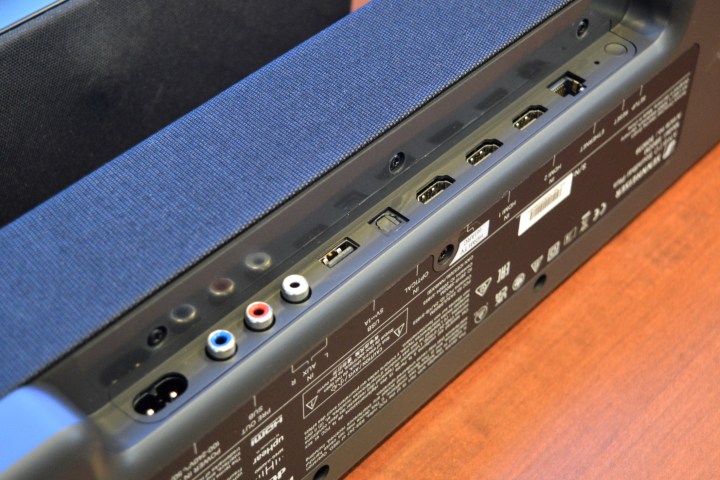
The subwoofer strategy
One of the perennial problems we’ve seen with flagship soundbars from companies like Bose, Sonos, and Bowers & Wilkins is a lack of HDMI inputs. They all use HDMI ARC/eARC to connect to a TV, but that always means giving up one of your TV’s precious few HDMI ports just so you can have great sound. The Ambeo Soundbar Plus has no such limitations. Not only does it offer two HDMI inputs in addition to its HDMI ARC/eARC port, but it also has discrete inputs for analog and digital optical devices
You can connect any powered subwoofer to the Ambeo Soundbar — not just Sennheiser’s.
But let’s not heap too much praise on Sennheiser for this. All soundbars should have at least a single HDMI input. It’s also worth noting that those two HDMI inputs only support HDMI 2.0a, which means that if you want to do 4K gaming at 120Hz, variable refresh rate (VRR), or 8K, you’ll have to plug directly into your TV. Assuming, that is, your TV’s ARC/eARC port isn’t the only port that can handle these HDMI 2.1 features.
Still, the Ambeo Soundbar Plus’s ports will happily passthrough 4K at 60Hz and all HDR flavors including Dolby Vision, so all of your non-gaming, non-8K needs are met.
If you want to plug a streaming stick into one of these HDMI ports, there’s a conveniently located USB-A port for power. You can also use it for manual firmware updates, but that’s all it does.
My favorite feature, however, is the subwoofer pre-out. Sennheiser’s new $700 Ambeo Sub can connect to the Ambeo Soundbar Plus wirelessly — in fact, you can connect up to four Ambeo Subs wirelessly if you want — but both the soundbar and the sub also offer RCA jacks for wired connections.
This means you can connect any powered subwoofer to the Ambeo Soundbar — not just Sennheiser’s. You can’t do that with Bose, Sony, Sonos, or the vast majority of other soundbars.
As with most high-end soundbars, setting up the Ambeo is done via an app on your smartphone. It’s fast and easy thanks to the intuitive, step-by-step interface of Sennheiser’s Smart Control software. It gets the bar connected to your Wi-Fi (or you can use Ethernet if you happen to have a cable near your TV), performs the room calibration using the onboard mics, and then guides you through the optional steps for using Alexa as a voice assistant and using Google’s Chromecast built-in.
If you don’t already have a smart speaker in your TV room, you might want to take advantage of Alexa, but don’t skip the Chromecast setup. Whether you have an iPhone or an Android device, Chromecast is a better choice than both Bluetooth and Apple AirPlay for audio streaming if your app supports it. For CD-quality tracks, there’s no real benefit, but if you’ve got access to lossless, hi-res audio from streaming services like Apple Music, Amazon Music, Qobuz, or Deezer, Chromecast will preserve all of that extra detail.
The app is by far the easiest way to access the Ambeo’s functions and settings, but here’s a pro tip: if you don’t want to use it, or you don’t own a device that’s compatible with Sennheiser’s app, the soundbar also has a web interface you can access via a browser.
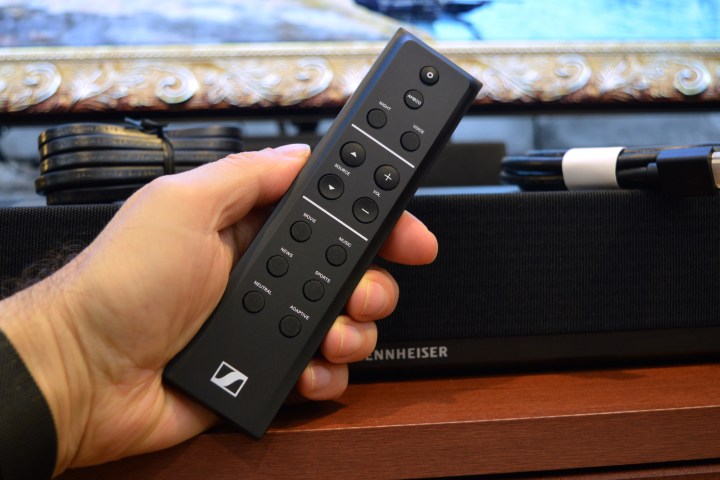
If you want, you can control the Ambeo Soundbar Plus just by using the app, but there’s also an included remote. It’s an unusually sturdy accessory. Most soundbar remotes (if the speaker comes with a remote at all) feel cheap, but this one has real heft to it. Unfortunately there’s no backlight, so you may struggle to use it in the dark.
You may also struggle with the way Sennheiser has chosen to implement volume muting. Instead of a dedicated mute button, muting is controlled via the “O” multifunction button, which, given its position on the remote and its icon, could easily be mistaken for a power button.
The Sennheiser Ambeo Soundbar Plus is the Penn & Teller of the Dolby Atmos Soundbar world.
If your audio is coming from your TV or one of the soundbar inputs, a single press of that button mutes the audio. However, if you’re streaming from Wi-Fi, Bluetooth, or Spotify/Tidal Connect, the single press acts as a pause (press it again to play).
OK, so far so good. It’s a bit unusual, but once you get used to it, it works well. But that’s the control scheme if you aren’t using the Soundbar Plus as an Alexa smart speaker. If you choose to activate Amazon’s voice assistant, the multifunction button goes through a metamorphosis, whereby a single press activates Alexa, and if you want to use the button’s previous muting and playback features, these now require three-second-long presses. I don’t know about you, but I just don’t have the patience to wait three seconds to control volume or playback.
Confusing LEDs
I’m also confused by the way the soundbar provides visual feedback. That top-mounted LED strip is quite the versatile indicator, with a variety of colors and animations for things like volume, mode, muting, etc. But because of its position — set toward the back edge — you may not be able to see it at all. Ideally, it should be front and center, located where the Sennheiser word mark appears, right under the grille — the exact place Sennheiser placed the OLED display on the Soundbar Max.
The speaker also can confirm when it’s receiving Dolby Atmos or DTS:X signals, but these tiny indicators are even harder to see. They sit on the top surface, behind the raised front edge of the grille, which obscures them unless you’re looking down at them. The Ambeo mode indicator, however, is very easy to see: it sits in the lower-right front corner.
The included quick-start guide offers a guide to many of these features — if you can decipher the Ikea-esque pictograms necessitated by the multi-anguage nature of the pamphlet. But to understand and use the Ambeo’s deeper features, you will absolutely need to consult the full instructions. Since Sennheiser doesn’t include them in the box or link to them from the Smart Control app, here are links to the downloadable version and the web-based version.
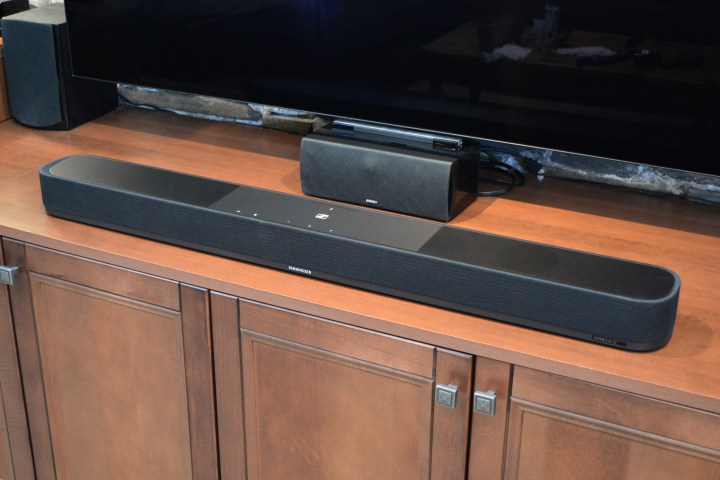
Now, let’s talk about the sound. Overall, the Ambeo Soundbar Plus is a sonic delight. There’s enough power on tap to envelop even the largest of rooms. In fact, it can get so loud, if you’re in a smaller to medium-sized room, be careful — we’re talking potentially harmful levels at the upper end of the range.
The twin built-in subwoofers are no match for dedicated subs, but they are as good or better at delivering low-end bass as any other single soundbar I’ve heard, with the possible exception of the Bang & Olufsen Beosound Stage and the Ambeo Soundbar Max.
Sennheiser was kind enough to lend me an Ambeo wireless sub to try with the new bar, and as you’d expect, it provided plenty of cinematic rumble. But unless you want to take advantage of that wireless connection or the Ambeo’s ability to manage four of these bad boys simultaneously, you might be better off spending that Ambeo Sub money ($700) on a wired sub of your choosing.
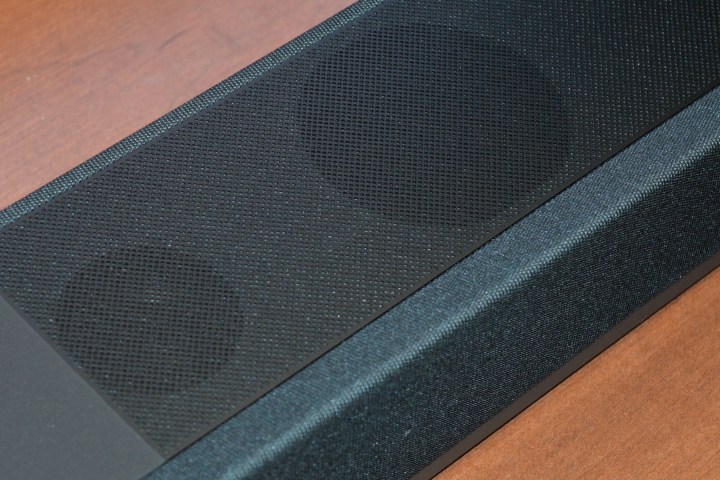
Good Dolby Atmos soundbars have top-notch acoustic components (the drivers, amplifiers, etc.), and a sufficient number of drivers to project sound around a room. Great Dolby Atmos soundbars, on the other hand, also have the kind of software — or digital signal processing (DSP) if you want to get technical about it — that can give a rectangular box of drivers the ability to fool your ears into thinking you’ve got a room full of speakers. And the Sennheiser Ambeo Soundbar Plus is the Penn & Teller of the Dolby Atmos Soundbar world.
With the exception of the Ambeo Soundbar Max, I don’t think you can get a more immersive audio experience from a single speaker than the Ambeo Soundbar Plus. It’s certainly true when you feed it multichannel object-based surround sound formats like Dolby Atmos or DTS:X, but it can be just as thrilling when listening to 5.1, 7.1, or even good ol’ two-channel stereo.
The secret sauce is Sennheiser’s Ambeo mode, which supercharges 3D formats and “upscales” non-3D formats. Using the information gathered during the room calibration step, it attempts to place so-called phantom speakers around your room in a 7.1.4 configuration (front, surround, rear, height, and a subwoofer). It works brilliantly.
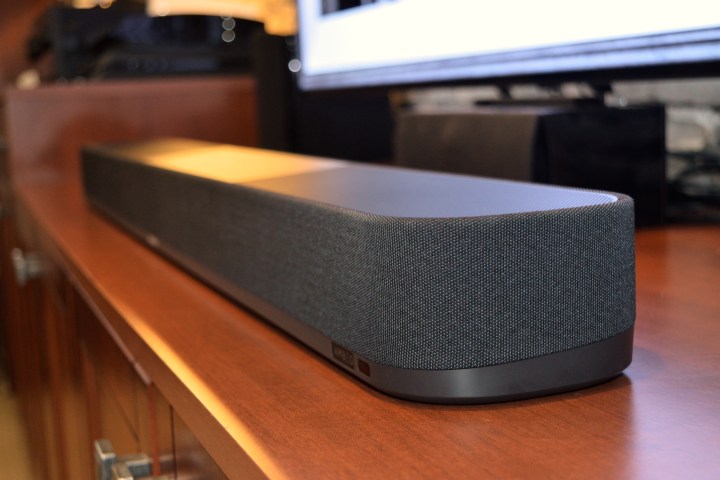
The taste test
Two of my favorite recent Atmos torture tests — the initial sandworm sequence from Denis Villeneuve’s Dune and the Aston Martin chase/shootout sequence from No Time To Die — passed with flying colors. The eerie whispering voices young Paul Atreides experiences as he’s engulfed in a spice-saturated sand cloud, float around the room like disembodied ghosts. And as the camera pulls back on a cornered James Bond, it passes through a set of three tolling bells (don’t ask for whom the bell tolls), which dutifully move from either side of you to the front of the room, echoing overhead as they go.
These are the effects that make Dolby Atmos so enjoyable, and why you need a highly capable soundbar to hear them. Just as important, the dialogue remains clear and distinct, a critical test for any TV speaker.
If there’s one thing that could make the Ambeo Soundbar Plus even better, it would be if Sennheiser offered a set of matching wireless surround speakers. Sony, Bose, and Sonos have this as an option, and LG, Samsung, and Vizio package their flagship soundbars with them.
I’m not saying that the Ambeo system needs them, but there’s a natural limit to just how much of a true, 360-degree sound field can be generated by virtualization alone.
As a technology, Ambeo isn’t unique. Sony does something very similar on its $1,300 HT-A7000 via that speaker’s Immersive AE (IAE) mode. I think Ambeo is superior, at least for movies and TV content. When it comes to music, IAE offers a more natural sound. If at any point you don’t like what the Ambeo processing is doing, you can disable it with a single button press on the remote.
But this brings us to a key differentiator between the Ambeo Soundbar Plus and most of the competition: EQ settings. Most soundbars offer “modes” — think of them as presets designed to help you get the most out of specific kinds of content. On the Ambeo, they are Neutral, Movie, Music, News, Sports, and Adaptive. The first five are self-explanatory, while the sixth is an autopilot mode that reacts to whatever you’re listening to.
On other speakers, the modes are static. You either like what they do to the sound or you don’t. Sennheiser makes no such assumptions about its tuning. Each mode lets you tweak its specific sound signature with a four-band EQ, plus you can decide how strong the Ambeo effect should be when Ambeo mode is engaged: light, regular, or boost.

Better still, the soundbar will remember which of these modes you last used on an input-by-input basis. So if you mostly watch sports via your TV, movies via your streaming stick, and music via the optical port, you can set those preferences once, and then forget about them.
On the music side of the equation, the Ambeo Soundbar Plus is a solid performer. As with most soundbars, it won’t replace a dedicated set of high-quality stereo speakers. Instead, think of it as a more immersive way to experience two-channel sound and a great way to experience multichannel music like Dolby Atmos Music.
This is when those deeper Ambeo and EQ-based settings really come in handy. Boost-level Ambeo is way too much — it can cause some really unpleasant peakiness in the higher frequencies. But light level is very enjoyable, and with some EQ experimentation, I suspect you’ll be able to get things dialed in just the way you like them.
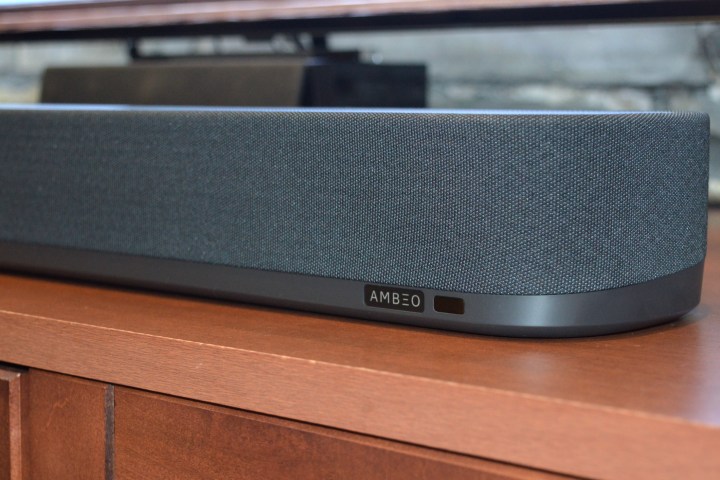
I’m a little less enthusiastic about the music management side of things. The speaker has no shortage of connection and format choices: AirPlay, Chromecast built-in, Bluetooth, Tidal and Spotify Connect, and Sony’s 360 Reality Audio (360RA) — not bad at all. As long as you’re content to use third-party streaming music apps on your smartphone, maybe that’s enough.
But unless you use Google Home or Amazon Alexa, there’s no built-in way to do multiroom audio. The Smart Connect app has no option for accessing your personal music library, and the Bluetooth connection is limited to SBC and AAC codecs.
The Sennheiser Ambeo Soundbar Plus might not be as expandable as Sonos or Bose, it might not possess Sony’s support for advanced gaming and 8K content, and it suffers from a few usability issues. But it delivers an absolutely astonishing immersive 3D performance, it has plenty of connectivity options, and it’s one of the few soundbars that lets you choose your own subwoofer.
If you want to install a single speaker that will blow your mind without blowing out your bank account, this is your next soundbar.


